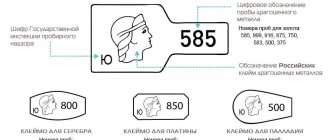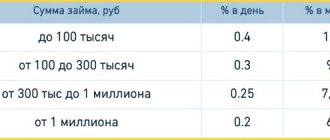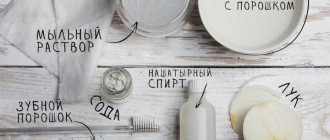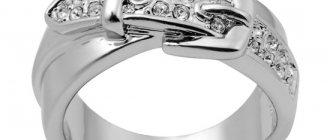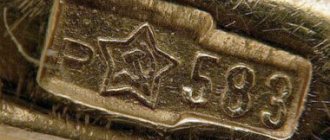When receiving a piece of jewelry as a gift or purchasing it, each of us at least once in our lives paid attention to the numbers hidden on the inside. What do they mean and how to decipher them? Knowing how to parse the information hidden in this symbolism, you can easily read the data on any product that has a sample.
The purest, 100% alloy of precious metals is practically impossible to find in nature, and in this form they are not very resistant to external factors. Impurities added to metal are called alloys. A variety of components can be added, often nickel, copper, zinc and silver. Depending on what characteristics of the alloy need to be improved, a certain amount of the desired ingredient is added to it.
The stamp on the jewelry is a sample consisting of numbers, letters and an image, which are framed with a special frame. Its appearance is different and depends on the material used in the manufacture of the product. For gold it will be in the shape of a spatula, for silver it will be a barrel, you will recognize platinum by its octagon-shaped frame, and for palladium it will be a teardrop shape.
What are gold hallmarks?
The ratio of base metals in the alloy determines its quality indicator. These metals include gold (aurum), silver (argentum), copper (cuprum). The legislation of the Russian Federation establishes the mandatory marking of any alloys based on precious metals. An imprint is made on the jewelry indicating the quality of the alloy. This impression is called a hallmark or stamp. Historically, marks in different countries of the world corresponded to the weight standards used. The metric system indicates parts of 99.99% pure gold in 1000 parts of the alloy.

Carat sample system
Gold with a content of 99.99% in the alloy is considered absolutely pure. In the karate system, this indicator is designated 24k. Further, in descending order, the standard 23k, 22k, 18k, 14k, 12k, 9k, 8k carat values are used. What does the karat mark mean on gold jewelry? An 18 carat piece of jewelry means that there are 18 parts of pure yellow metal in 24 parts of the alloy. This system is used in the USA, Canada, Asian countries and some European countries.
Spool sampling system
The spool system, introduced in 1798 during the reign of Russian Emperor Pavel Petrovich, is primordially Russian. It was based on the weight standard used at that time - the Russian pound, which consisted of 96 spools. When the stamp was installed in 96 spools, the gold content in the alloy being tested was 99.99%. Further, this figure decreased to 36 spools. To convert from a spool system to a carat system, it is necessary to divide the stamp indicator by 4.
Assay marks of Russia and foreign countries
From the mid-17th century in Rus', the use of a double-headed eagle began to be used for branding gold and silver items. The content of pure gold during this period was 83–85%, which corresponded to the purity of imported gold coins, thalers or efimkas, from which jewelry was made. The hallmarking of gold objects in Rus' was legalized by a royal decree under Peter the Great in 1700. In Russia, the 56th sample is most widespread, which corresponds to the modern 585.
During this period, city coats of arms and the number of spools in a ligature pound were used for branding. Since 1899, a woman’s face in a kokoshnik has been used for branding, which in 1927 was replaced by the profile of a worker with a hammer, and since 1957, a hammer and sickle against the background of a five-pointed star. In Asian countries, hieroglyphs were used for branding. In Europe - coats of arms of countries and cities indicating the fineness in carats. The type of mark designation should not differ greatly for different manufacturers.
Current notation systems
Gold alloys differ in the content of the main noble metal. To distinguish them from each other, a specially developed notation system is used. The sample is a designation of the alloy alloy and also contains special signs that guarantee the presence of precious metal in the product.

Today, there are four sample systems in the world, two of which are used: carat and metric. The spool and lot gold sampling systems are a thing of the past. The first of them was used in Russia and was based on the use of the Russian pound, consisting of 96 spools. It was used until 1927, when they switched to the metric system. The lot system was used in Germany, but there the transition to metric samples was made even earlier - in 1888.
The karat gold standard system is common in the USA, Canada, and some other Western countries. According to accepted designations, a precious metal marked 24 carats is considered pure - it does not contain any impurities. The remaining designations - 9, 10, 14 and 18 carats - are used to mark yellow metal alloys. 18 carat gold contains 18 parts of the precious metal itself and 6 parts of other alloy elements.
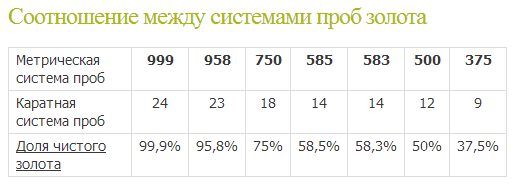
In the metric system, it is even easier to determine the proportion of precious metal in an alloy by numerical marking, since it indicates how many grams of gold are contained in a kilogram of jewelry raw materials. The most famous alloy 585 marking contains 585 g of gold and 415 g of other components in 1 kg of mass.
When purchasing precious jewelry, you should look at the standard of gold. Confusion can arise when purchasing jewelry abroad, where the marking is indicated in carats. How to convert carats into the usual Russian standards? 9 carats correspond to the 375 marking of the precious metal, 14 carats - 585 marking, 18 carats - 750 marking, and 24 carats are identical to pure metal 999 fine. The metric system does not have a marking corresponding to the 10 carat marking: it is an intermediate alloy between the 375 and 585 markings.
What types of gold are there?
In life, we come across jewelry made from this “despicable” metal (earrings, chains, rings) of different colors. Additional inclusions of other metals in the precious alloy are called ligatures. Objects, depending on the alloy content in the alloy, acquire green, red, orange, yellow, platinum and white color. The main contents of the alloy are silver, copper, platinum (palladium), zinc. In white base alloys, nickel is used instead of platinum. It is important for the buyer to know what standard gold is before going to a jewelry store.
999 sample
The highest quality score is 999. This alloy contains 0.01% impurities. It is practically pure gold. This alloy is not used for making jewelry because it is subject to deformation and has a dull yellow color. This alloy is used to create bank bars of various weights for sale to investors who want to save money or make money on the rise in the value of precious metals.
At all times, precious metal has always been in price. During periods of financial crises, the demand for it and other precious metals rises sharply. Their quotes on all world exchanges are the main economic indicators. Bank bullion is sold by all banks in the world and included in the deposit portfolios of large and small investors, and jewelry has always given women the opportunity to look rich and beautiful.
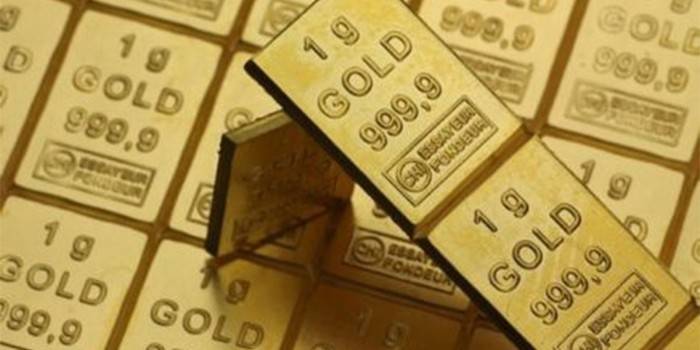
925 sample
Objects not only made of gold, but also of silver are subject to branding. If the product is marked 925, this means that this is high quality silver jewelry. The amount of pure silver in it is 92.5%. Germanium and cadmium are used as ligatures along with silver to maintain the original shine and prevent the jewelry from darkening over time. These additives were used by ancient masters and give a magnificent appearance to silver masterpieces.
875 sample
The 875 mark on the jewelry indicates a maximum percentage of silver of 87.5%. Items made from this metal are popular. They always tried to fake it. Possible replacement options for silver include alloys of lead, aluminum, and zinc. To give a silver shine, fakes are coated with pure silver. When purchasing jewelry made from precious metals, pay attention to the presence of the hallmark number on all parts of the pendant, chain or ring. Jewelry should be sold in a store only if it has a seal with the manufacturer's passport attached.
750 sample
To make it easier to understand what gold hallmark means, you should mentally break the product into 1000 parts or shares. The numbers 750 mean that this product contains 750 parts of pure precious metal. This is the highest standard of gold in jewelry used in industry. 75% gold combined with copper gives objects made from this alloy a characteristic reddish tint. 18K alloy is widely used to create jewelry in Asian countries, it is used to create gold plating for men's and women's accessories.
585 sample
The most common gold standard on an industrial scale is 585. The pure gold content in this alloy is 58.5%. The ligature in it is divided in the ratio of silver to copper, as 1 to 4.3. This is an experimentally established ratio of the volume of gold and additives. Jewelry with the 585 mark has a beautiful color and shine. In our country, pendants, chains, rings, earrings, brooches and bracelets are made from this alloy. To reduce the likelihood of counterfeiting, items made from this alloy are stamped 5S5 using the electric spark or laser method. It is more difficult to fake than a simple print.
- Causes and treatment of a lump of mucus in the throat
- Statins for lowering cholesterol - which drugs are better. Reviews and prices for statins to lower cholesterol
- Uterine prolapse
583 sample
In the first years of Soviet Power after 1927, the mark 583 was used (see photo below). This is the gold standard of the Soviet Union. Most of the rings and earrings we inherited from our parents are of this quality. In the post-war period, 14-karat gold was widely used in Europe. If 14 is divided by 24 and multiplied by 1000, the result is 583. A large number of wedding rings, jewelry with diamonds, rubies, sapphires and semi-precious stones are made from this alloy. In 2000, the 585 mark became the Russian standard.
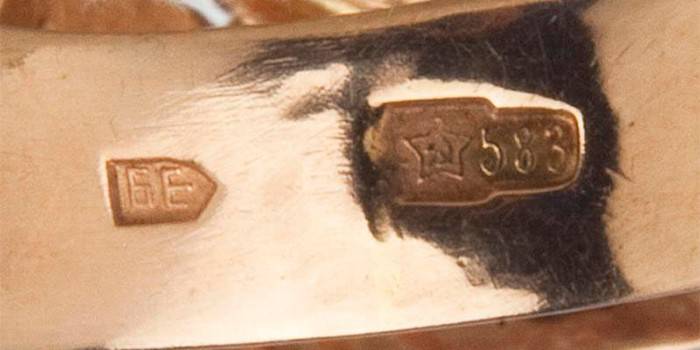
500 sample
If the content of yellow metal and alloy is equal, the sample becomes equal to 500. For industrial purposes, this standard is not used, but in production by private craftsmen this high-quality alloy composition is used. Jewelry made from it with an original design or with a special theme receives the opportunity to be fully appreciated. Abroad, brooches, cufflinks, and cigarette cases are made from 500-quality alloy.
385 sample
Gold jewelry with a quality index of 385 contains more than half of its volume of additional materials. With an increased copper content, jewelry acquires a reddish tint. Silver in the alloy gives products a whitish or even light white color. For the purpose of making jewelry, alloys with good malleability and low melting points are used. This temperature for aurum is 1080 degrees Celsius, for silver - 1550, for platinum - 1780. To reduce the melting point, zinc is used in the alloy.
375 sample
The cheapest quality alloy for making gold jewelry is 375. The large amount of copper and silver in it leads to rapid oxidation and the appearance of dark spots. If there are small parts, it is difficult to restore the original appearance. This alloy is inexpensive and makes it possible to produce mass-produced cheap jewelry. As long as jewelry production has existed, there have been organizations involved in standardization, accounting and control over the circulation of precious metals. In the Russian Federation, this is done by the Assay Chamber of Russia.
Jewelry testing from UvelirMoscow
Only government institutions, namely the Assay Supervision Inspectorate of the State Assay Chamber of the Ministry of Finance of the Russian Federation, are involved in applying and registering the hallmark on products from the UvelirMoscow studio.
The testing process itself occurs at the stage of 90-100% readiness, the specialist rubs the product with a special touchstone and after that the reagent of the required sample is applied. If the composition of the metal that was submitted for testing corresponds to the declared sample, then a sample is placed on it; if not, it is returned. In special cases, the metal is checked for its chemical composition by performing spectral analysis using X-rays or laser beams.
The jewelry workshop “UvelirMoscow” is a manufacturer of high-quality and reliable products, this is confirmed by relevant samples and documentation. When ordering or purchasing jewelry from us, you can be 100% confident in the authenticity of the products and the materials from which they were made.
Gold samples in the USSR
In the USSR, for the manufacture of jewelry and ritual products and semi-finished products from precious metals, GOST 30649-99 was used, which established the following types of gold samples:
| № | Try | Gold, % | Silver, % | Platinum, % |
| 1 | 375 | 37,5 | 10 – 25 | 4 |
| 2 | 500 | 50,0 | 10 | — |
| 3 | 585 | 58,5 | 19 – 29 | 10 |
| 4 | 750 | 75,0 | 10 – 24 | 14 |
| 5 | 958 | 95,8 | 2 | — |
| 6 | 999,9 | 99,99 | — | — |
Russian samples of precious metal
375 standard yellow metal contains only 37.5% gold, the rest is copper and silver. The color of the alloy directly depends on which of these components predominates in the alloy. Such jewelry material is considered low-grade, is characterized by a spectrum of shades from bright yellow to red and fades over time due to the formation of iron compounds on the surface.
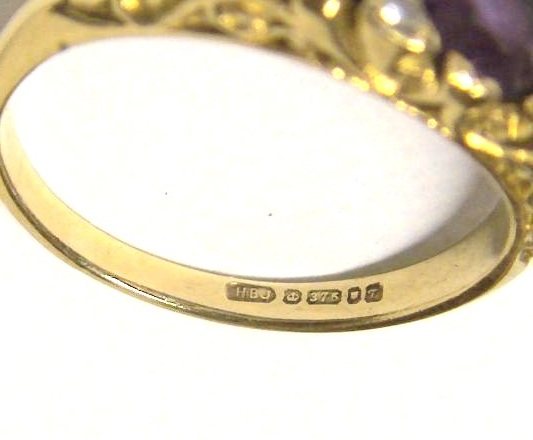
500 marking of the gold alloy is little known and is quite rare, as it refers to low-cast materials. What does this intermediate gold standard mean? The yellow metal content in the original jewelry raw materials is almost 51%, the rest is also allocated to silver and copper. Products with 500 markings oxidize slower than 375 metal, but are characterized by an unattractive tint.
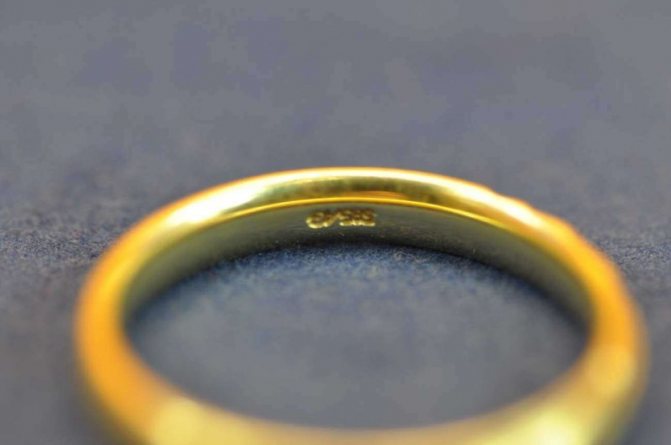
585 gold is the most beloved among both jewelry buyers and jewelers themselves. An alloy with this marking is used most often in jewelry; most precious jewelry is made from this material. The content of yellow precious metal in the alloy is 58.5%, the rest comes from four components: palladium and nickel are added to standard silver and copper. Master jewelers value the alloy with the 585 designation for its hardness and strength, which makes it easy to forge products. For consumers, jewelry made from such gold is attractive due to the preservation of a beautiful color during use, long service life and reasonable price.
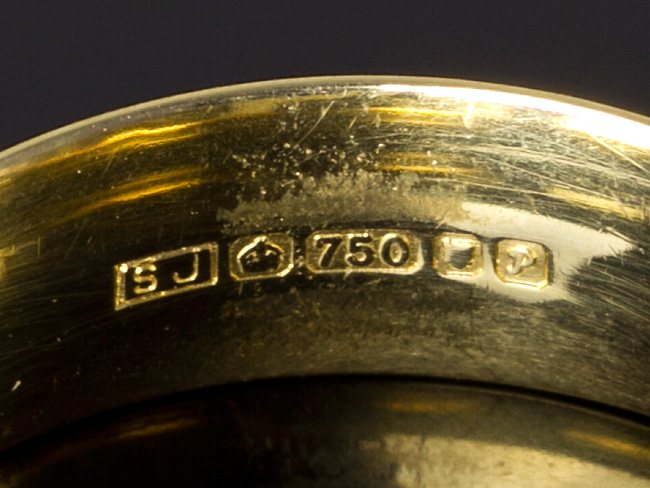
The 750 gold alloy contains 75% yellow precious metal; in addition to silver and copper, palladium and sometimes platinum are also considered additional components of the alloy. The color of the metal of this high marking can be very different: the palette contains shades of the red and green spectrum. The shade of the product depends on the ratio of the components of the ligature. Many buyers prefer 750 hallmark white gold, which contains more silver or expensive platinum.
750 standard precious metal is easily processed and used by jewelers to create jewelry with precious stones. The presence of many shades of the alloy allows craftsmen to create exclusive products with an unusual design.
Metal with 958 marking is used very rarely. Due to the high content of precious metal, the alloy is soft and easily deformed under mechanical stress. Unscrupulous sellers may offer customers gold with a 925 hallmark that does not exist. Hallmarks 958 for gold and 925 for silver have nothing in common with each other. If they try to sell you metal with the designation 925 on the stamp, then what you are looking at is clearly not gold jewelry; at best, they are offering you a gold-plated silver product, at worst, a fake. The high quality yellow metal is marked 958 or 999. Material with 958 hallmarks is used to make custom collectible jewelry; it is very rarely found in ordinary jewelry stores.

Among gold samples, the highest marking is 999, which is pure metal, which is also called red. The highest grade metal is very soft, it is impossible to use it to create jewelry and other jewelry items: it is difficult to process and easy to deform. Only bank bars are now made from the pure element, intended for those wishing to invest in the precious metal.
What are the hallmarks of gold with letters?
The old masters did not issue certificates to their masterpieces. To distinguish jewelry items, a convex marking was made with a company monogram or designation of who and where the jewelry was made. Some jewelers add additional hallmarks to the gold to make their products stand out from the crowd. This sign is called a “name sign”. It is placed next to the brand and consists of 4 letters. The first letter indicates the year of manufacture. The second letter will indicate the place where the products were tested in accordance with the catalogue. The last 2 letters contain the name of the manufacturer.
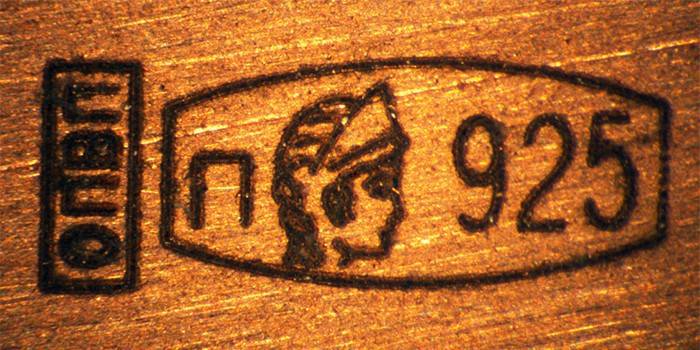
Why do some people blush while others turn pale? What does an orthostatic test help assess?
Every person’s body contains an invisible manipulator, whose work is invisible to consciousness. This is the autonomic (also called autonomic) department of the nervous system. It controls the functioning of all organs, including the heart and blood vessels.

The autonomic nervous system consists of two sections, the functions of which are completely opposite:
- The sympathetic department is activated during stress, physical activity, and anticipation of danger. It makes your heart beat harder and faster.
- The parasympathetic department predominates at rest, sleep, and during meals. The heart calms down, the pulse slows down.
The two departments do not always work in harmony; they do not always “switch on” on time and with the required strength. In some people, the parasympathetic department is constantly trying to “pull the blanket over itself,” while in others it is the sympathetic department. It is important to know about these features, for example, when a person plans to engage in certain sports. An imbalance in the functioning of the autonomic nervous system occurs in some diseases, for example, vegetative-vascular dystonia.
The orthostatic test helps evaluate the excitation of the sympathetic nervous system in response to changes in body position, and together with the clinostatic test, the parasympathetic one.
Call. We work around the clock
Which standard of gold is better
Comparing the price and appearance of jewelry, 585 standard has become widespread in European countries. Jewelry made from it retains its original appearance for a long time. The cost of such goods is lower than products made from 22 and 24 carat aurum of Arab sheikhs. Taking into account the use of zinc, the melting point is low. The mark on gold items is made in areas that are invisible during use - inside rings, on the clasps of chains and earrings. Nowadays, jewelry made by Italian craftsmen is considered the most exquisite and elite.
The most expensive gold sample
The highest quality in jewelry in the metric system is pure gold with a purity of 99.99%. Chemically pure, 24-karat gold is widely used in Arab countries. In the jewelry markets of Dubai you can see jewelry of huge sizes and bright yellow color. There is a historical explanation for this. The history of industry in these countries is more modest than in Europe. 50 years ago, in their place there was a desert, with Bedouins wandering through it. Jewelry was made by hand, and its size was supposed to confirm the wealth of its owners.


